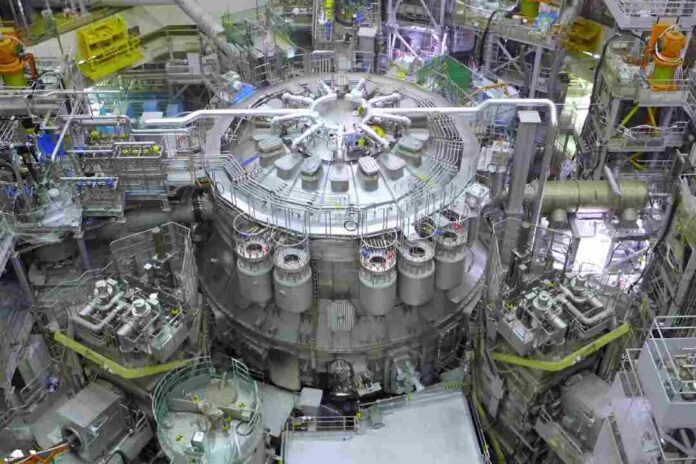The world is facing an unprecedented challenge in meeting its future energy needs while minimizing the impact on the environment. Traditional energy sources are depleting, and the burning of fossil fuels is contributing to climate change. As a result, scientists and engineers have been tirelessly exploring alternative energy solutions. One such solution that has garnered significant attention is nuclear fusion. The JT-60SA, the world’s largest experimental nuclear fusion reactor, recently inaugurated in Japan, marks a significant milestone in the quest for clean, sustainable energy. In this article, we will delve into the intricacies of nuclear fusion, its potential as a safe and carbon-free energy source, and the groundbreaking advancements achieved by the JT-60SA reactor.
Nuclear fusion is a process that involves the merging of two atomic nuclei to form a heavier element. Unlike nuclear fission, which is currently used in nuclear power plants, fusion releases immense amounts of energy by combining atomic nuclei rather than splitting them. The ultimate goal of fusion research is to replicate the process that takes place inside the Sun, where hydrogen nuclei fuse together to form helium, releasing vast amounts of energy in the form of light and heat.
The JT-60SA Reactor: A Breakthrough in Fusion Research
In Japan, the JT-60SA reactor stands as a testament to humanity’s pursuit of sustainable energy solutions. This six-story-high machine, located in Naka, north of Tokyo, is a joint project between the European Union and Japan. The JT-60SA reactor serves as a precursor to the construction of the International Thermonuclear Experimental Reactor (ITER) in France. The primary aim of the JT-60SA reactor is to investigate the feasibility of fusion as a safe, large-scale, and carbon-free source of net energy.
The centerpiece of the JT-60SA reactor is a donut-shaped “tokamak” vessel that contains swirling plasma heated to an astonishing temperature of 200 million degrees Celsius. This extreme heat is necessary to initiate and sustain the fusion reactions. By achieving controlled fusion reactions and generating more energy than is input into the system, the JT-60SA reactor aims to demonstrate the viability of fusion as a practical energy source.
Net energy gain, the Holy Grail of fusion research, refers to the ability to produce more energy from a fusion reaction than is used to initiate and sustain it. Despite significant progress, achieving net energy gain has remained an elusive milestone. In December of last year, the National Ignition Facility at Lawrence Livermore National Laboratory in the United States achieved net energy gain using a different fusion method called inertial confinement fusion. This method involves using high-energy lasers to compress and heat a small amount of hydrogen fuel, triggering fusion reactions. The successful demonstration of net energy gain at this facility marked a landmark achievement in the pursuit of clean and unlimited power.
The development of the JT-60SA reactor and other fusion research projects is a testament to the power of collaboration and innovation. More than 500 scientists and engineers, along with 70 companies from Europe and Japan, have come together to contribute their expertise and resources to advance fusion research. The European Union and Japan’s joint efforts in the JT-60SA project highlight the global commitment to developing sustainable energy solutions.
Advantages of Nuclear Fusion
Nuclear fusion offers several advantages over traditional energy sources, such as fossil fuels and nuclear fission. Unlike fission, fusion reactions carry no risk of catastrophic nuclear accidents. The devastating events at the Fukushima Daiichi nuclear power plant in Japan in 2011 underscore the need for safer and more reliable energy sources. Fusion reactors also produce significantly less radioactive waste compared to current nuclear power plants, addressing concerns about long-term waste management.
Furthermore, fusion is a virtually limitless source of clean energy. Hydrogen isotopes, the fuel required for fusion reactions, can be abundantly found in seawater and other readily available sources. Harnessing the power of fusion would reduce our dependence on finite resources and contribute to a more sustainable future.
Challenges and Future Prospects
While the recent achievements in fusion research are undoubtedly significant, several challenges lie ahead. The construction of the ITER project, for example, has faced budget overruns, schedule delays, and technical issues. However, these challenges are not unexpected in such pioneering endeavors, and they highlight the complexity of achieving controlled fusion reactions.
Despite the hurdles, fusion research continues to progress, driven by the immense potential it holds as a clean and abundant energy source. Scientists and engineers worldwide dedicate themselves to overcoming the remaining obstacles and achieving net energy gain. Fusion has the potential to revolutionize the energy landscape, becoming a key component of the energy mix in the second half of this century.
The inauguration of the JT-60SA reactor marks a significant milestone in the pursuit of sustainable energy solutions. Nuclear fusion holds the promise of providing clean, safe, and virtually limitless energy. The collaborative efforts of scientists, engineers, and industry leaders demonstrate the global commitment to advancing fusion research. Despite persistent challenges, scientists, engineers, and industry leaders are bringing us closer to a future powered by this revolutionary technology through breakthroughs in fusion reactors and the pursuit of net energy gain. As we navigate the complexities of meeting our energy demands while preserving the planet, nuclear fusion stands as a beacon of hope, offering a viable solution to humanity’s future energy needs.

-We do nor know yet if this is a clean energy source. –Neither do we know if the JT-60SA reactor is a breakthrough. —The resources allocated to the important fusion research are small as compared to the huge military technology.
The sun’s fusion reaction may be the prime example driving research for human endeavors into generating fusion reactors for another alternate source of energy less hazardous than fossile and nuclear power generation. I recall an article in Popular Science with an image of a tokamat donut shaped fusion reactor, never understanding the concept. This was decades ago. Research reqires dedication and billions of dollars in investment with participants in every part of the world for attempting this new form of energy production.